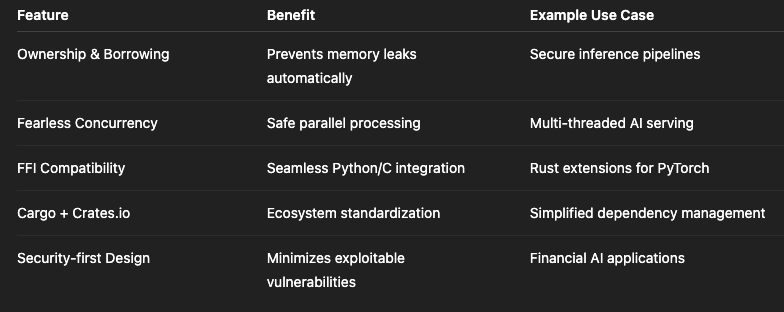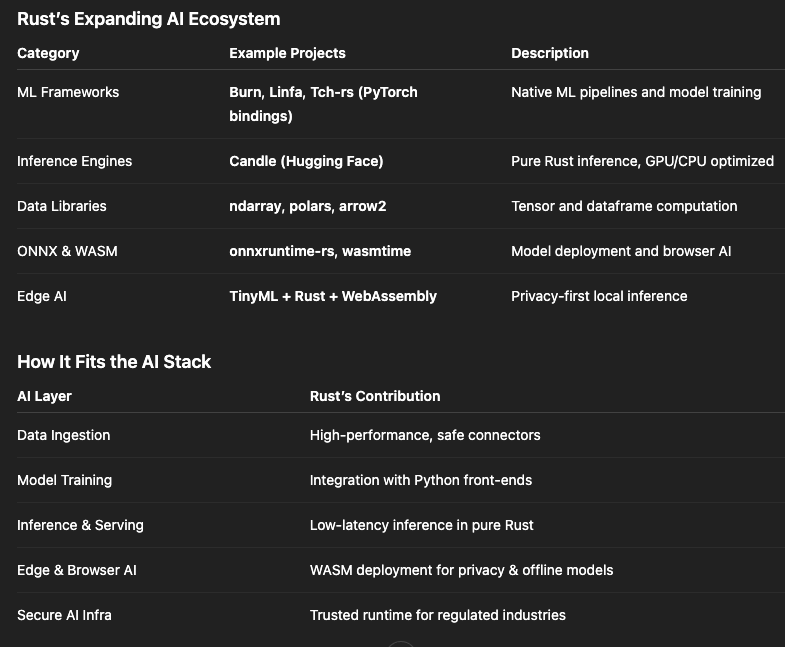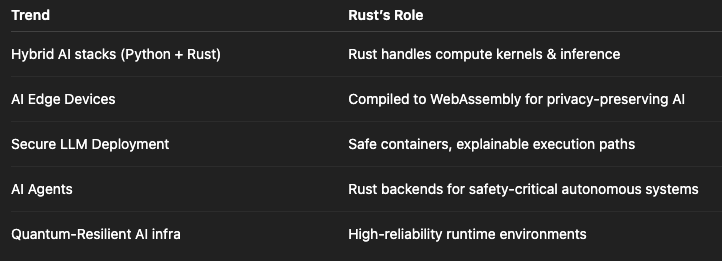
🦀 Rust in AI
Rust is quietly becoming the backbone of safe and scalable AI systems. Learn how this high-performance, memory-safe language is redefining inference, cloud, and edge AI — ensuring the next generation of intelligence runs fast and responsibly.
Arun Natarajan
3 min read


Introduction
In an era where artificial intelligence drives every innovation cycle, one programming language is quietly redefining the foundation of safe, high-performance computing — Rust.
Born out of frustration with the pitfalls of memory-unsafe systems, Rust is now emerging as the backbone for AI infrastructure, edge inference, and privacy-centric computing. Its promise is simple but powerful: “Fearless performance with safety.”
1. A Brief History of Rust
Rust began as a personal side project by Graydon Hoare in 2006, who envisioned a language that delivered C++ speed without its safety headaches.
Mozilla backed the idea, and by 2015, Rust 1.0 became a stable, open-source release.
Since then, it has evolved under the Rust Foundation, supported by giants such as Microsoft, AWS, Google, and Huawei. In 2023, Rust made history by being integrated into the Linux kernel, signaling its readiness for production-grade systems.
🏁 Key Milestones
2010 – Mozilla sponsors Rust development
2015 – Rust 1.0 released
2018 – Servo (Rust-based browser engine) powers parts of Firefox
2021 – AWS Firecracker (serverless container) written in Rust
2023 – Rust enters Linux kernel
2025+ – Rust becomes the performance layer of AI infrastructure
2. Why Rust Stands Apart
Rust’s design solves three critical problems that have long plagued modern software:
Memory safety (no dangling pointers or buffer overflows)
Concurrency safety (no data races in multithreaded environments)
Zero-cost abstractions (performance equivalent to C/C++)
3. How Rust Is Used Today
Rust has already proven itself across mission-critical systems:
Cloud Infrastructure:
AWS Firecracker, Microsoft Azure services, Cloudflare proxies.
→ Rust handles high concurrency at low latency.Operating Systems:
Linux kernel, Windows components.
→ Enhancing stability and reducing memory-based vulnerabilities.Blockchain & Crypto:
Solana, Polkadot, and NEAR.
→ Safe parallel execution for smart contracts.Security & Networking:
Rustls (TLS), Tauri (secure desktop apps).
→ Secure-by-design system layers.
4. Rust Meets AI: From Training to Inference
AI development today faces two tensions:
Python’s productivity vs. performance limitations
C++’s speed vs. unsafe complexity
Rust bridges this gap — offering C++-like performance with Python-level reliability when paired through bindings.
5. Real-World Examples
Hugging Face Candle (2023):
A pure Rust deep learning framework optimized for inference — small binaries, GPU-ready, and WebAssembly compatible.AWS Firecracker:
Rust micro-VM powering AWS Lambda — ultra-light, secure sandboxing for serverless AI.OpenAI Tokenizers:
Core components (text parsing, data prep) are written in Rust for speed and memory safety.Polars DataFrame Library:
A Rust-based dataframe engine outperforming pandas and used in many production ML workflows.
6. Why Rust Is the “AI Infrastructure Language”
AI’s next phase requires systems that are:
Fast enough to process trillion-parameter models
Safe enough for regulated domains
Composable across cloud and edge environments
Rust fits that blueprint perfectly.
“If Python is the language of AI innovation, Rust is the language of AI reliability.”
Rust will not replace Python — it will fortify it, powering the unseen layers that make AI secure, scalable, and explainable.
7. The Regulatory & Risk Perspective
As frameworks like NIST AI RMF, ISO/IEC 42001, and EU AI Act push for auditability, safety, and traceability, Rust becomes strategically important for AI risk governance.
Why Regulators Love Rust:
Predictable execution, no unsafe memory access
Deterministic behavior supports model traceability
Reduced attack surface for adversarial exploits
For financial services, defense, and healthcare, this is not just a performance story — it’s a trust story.
8. What’s Next: 2025–2030
9. Conclusion
Rust represents the quiet revolution of the AI era — a language engineered for safety, speed, and trust.
In a world where AI is everywhere — from your browser to your banking system — Rust ensures that intelligence runs fast, secure, and accountably.
“AI will scale safely when its infrastructure speaks Rust.”
Downloadable version of this article: PDF
Suggested External References:
Disclaimer
The views expressed in this article are solely my own and are based on a review of publicly available information from reputable sources and industry analyses. This content is intended for educational and informational purposes only and does not represent the views, policies, or positions of my employer or any other organization.






